Wine lovers are always on the lookout for quality wines that don't break the bank. Fortunately, there are some great options available that offer high alcohol content at an affordable price. Whether you're a fan of red, white, or bubbly wines, there are plenty of options to choose from.
Some of the cheapest wines with the highest alcohol content include Taylor Marsala, Rex Goliath Cabernet Sauvignon, and Bogle Petite Sirah. These wines offer a great value for their price point and are perfect for those looking to enjoy a glass of wine without spending a fortune. Additionally, California's Central Valley is home to Zinfandel and Petite Sirah wines with elevated alcohol content and reasonable price points. Proper wine storage is essential for maintaining quality and taste, so it's important to store these wines correctly to ensure they taste their best.
Understanding Wine Alcohol Content
Wine is an alcoholic beverage made from fermented grapes or other fruits. Alcohol content is an essential aspect of wine, as it affects the taste, aroma, and body of the wine. The alcohol content of wine is measured by ABV (Alcohol by Volume), which is the percentage of alcohol present in the wine.
Winemakers control the alcohol content of wine by controlling the fermentation process. Yeast converts the sugar in grapes into alcohol during fermentation. The longer the fermentation process, the higher the alcohol content of the wine. Winemakers can also use various techniques to increase or decrease the alcohol content of wine, such as adding sugar or water.
The alcohol content of wine varies widely, ranging from as little as 5.5% ABV to as much as around 20% ABV. High alcohol wines are typically those with an ABV between 13% and 17%. These wines have a pronounced alcohol presence without overwhelming the wine's other characteristics.
Wine drinkers can use the alcohol content of wine to choose the right wine for their preferences. Those who prefer lighter wines may opt for wines with lower alcohol content, while those who prefer bolder, more full-bodied wines may prefer wines with higher alcohol content.
It is essential to note that higher alcohol content does not necessarily mean higher quality wine. The quality of wine depends on various factors, such as grape quality, winemaking techniques, and aging. Wine drinkers should choose wine based on their taste preferences and not solely on alcohol content.
High Alcohol Content Wines
When it comes to wine, the alcohol content can vary greatly depending on the type and brand. For those looking for a wine with a higher alcohol content, there are several options available. In general, high alcohol content wines have an ABV (alcohol by volume) between 13% and 17%.
Red Wines
Red wines are often associated with a higher alcohol content, particularly those made from bold varietals such as Zinfandel, Petite Sirah, and Shiraz/Syrah. These wines tend to have a fuller body and richer flavor profile, which can help balance out the alcohol content. Some popular high alcohol content red wines include:
- The Original Smoking Loon Zinfandel (14.5% ABV)
- Shiraz from the Rhône Valley (up to 15% ABV)
- Petite Sirah from California (up to 15% ABV)
White Wines
While white wines are generally lower in alcohol content than red wines, there are still some options for those looking for a higher ABV. Chardonnay and Pinot Grigio are two varietals that can have a higher alcohol content, particularly when grown in warmer climates. Some high alcohol content white wines include:
- Chardonnay from California (up to 15% ABV)
- Pinot Grigio from Italy (up to 13.5% ABV)
Fortified Wines
Fortified wines, such as Port, Sherry, and Madeira, are wines that have had additional alcohol added to them during the fermentation process. This results in a higher ABV and a sweeter flavor profile. Some high alcohol content fortified wines include:
- Taylor Marsala (up to 20% ABV)
- Sandeman Fine Tawny Port (up to 19.5% ABV)
- Bodegas Dios Baco Amontillado Sherry (up to 18% ABV)
Sparkling Wines
Sparkling wines, including Champagne and Asti, are typically lower in alcohol content than still wines. However, there are some options for those looking for a higher ABV. Some high alcohol content sparkling wines include:
- Champagne from France (up to 12.5% ABV)
- Asti from Italy (up to 9.5% ABV)
Late Harvest Wines
Late harvest wines are made from grapes that have been left on the vine longer than usual, resulting in a higher sugar content and a sweeter flavor profile. This can also lead to a higher alcohol content. Some high alcohol content late harvest wines include:
- Moscato from California (up to 12% ABV)
- Sauternes from France (up to 14% ABV)
Overall, there are many options for those looking for a high alcohol content wine. It is important to keep in mind that a higher ABV can also mean a higher price point, so it may take some searching to find the perfect wine at the perfect price.
Cheapest High Alcohol Content Wines
For those looking for a cheap bottle of wine that packs a punch, there are several options available. Flipflop, Firefly Ridge, and Rex-Goliath are some of the cheapest wines with the highest alcohol content, according to Liquor Laboratory. These wines range from 12-13% ABV and cost less than $5 for a 750 ml bottle.
Grocery stores may also carry wines with higher alcohol content at a reasonable price point. California's Central Valley is home to Zinfandel and Petite Sirah wines with elevated alcohol content and reasonable price points, according to Kings of Wine.
For those looking for white wine with the highest alcohol content, there are options available. According to Real Simple, some of the highest ABV white wines include E & J Gallo Winery's Moscato and Barefoot Cellars' Sweet White Blend, both of which have an ABV of 10.5%. However, it is worth noting that these wines may not be the cheapest options available.
When looking for a cheap wine with high alcohol content, it is important to keep in mind the storage and aging of the wine. Proper wine storage is essential for maintaining quality and taste, according to Kings of Wine.
In summary, there are several options available for those looking for a cheap wine with high alcohol content. Flipflop, Firefly Ridge, and Rex-Goliath are some of the cheapest options available, while grocery stores may also carry wines with elevated alcohol content. It is important to keep in mind the storage and aging of the wine for maintaining quality and taste.
Factors Affecting Alcohol Content in Wine
The alcohol content of wine is one of the most important factors that determines its taste, texture, and overall quality. Several factors affect the alcohol content in wine, including the type of grapes used, sugar content, climate, and harvest.
Grapes
The type of grape used in winemaking plays a crucial role in determining the alcohol content of the wine. Some grape varieties, such as Cabernet Sauvignon, have a higher sugar content than others, resulting in a higher alcohol content when fermented. On the other hand, grapes with lower sugar content, such as Pinot Noir, produce wines with lower alcohol content.
Sugar Content
The sugar content of grapes is the primary factor that determines the alcohol content in wine. During the fermentation process, yeast consumes the sugar in the grapes and produces alcohol as a byproduct. The more sugar in the grapes, the more alcohol the wine will contain.
Climate
The climate in which grapes are grown also affects their sugar content and, therefore, the alcohol content of the resulting wine. Warmer climates tend to produce grapes with higher sugar content, resulting in wines with higher alcohol content. Cooler climates, on the other hand, produce grapes with lower sugar content, resulting in wines with lower alcohol content.
Harvest
The timing of the harvest can also affect the alcohol content of wine. Grapes harvested earlier in the season tend to have lower sugar content and, therefore, produce wines with lower alcohol content. Grapes harvested later in the season have higher sugar content and produce wines with higher alcohol content.
Dry Wines
Dry wines, which have little to no residual sugar, tend to have higher alcohol content than sweet wines. This is because all of the sugar in the grapes is fermented into alcohol, resulting in a higher alcohol content.
Moderate Alcohol Content
It is worth noting that wines with moderate alcohol content are often considered to be of higher quality than wines with extremely high alcohol content. Wines with alcohol content above 15% can be overpowering and unbalanced, while wines with alcohol content below 10% can lack body and depth.
In conclusion, several factors affect the alcohol content in wine, including grape variety, sugar content, climate, and harvest. Winemakers carefully consider these factors to produce wines with the desired alcohol content and flavor profile.
Tasting Notes and Pairings
When it comes to wine tasting, the flavor profile of a wine is one of the most important factors to consider. Cheapest wines with the highest alcohol content tend to be full-bodied and have a more pronounced flavor profile. These wines are usually rich, with a fruity flavor and a hint of pepper and vanilla.
To balance the richness of these wines, it is important to pair them with acidic foods. Cheeses like cheddar and gouda, charcuterie, and grilled meats are great options for pairing with high alcohol wines. The acidity in these foods helps to cut through the richness of the wine and balance out the flavors.
When it comes to fruity flavors, wines with high alcohol content tend to have a berry flavor profile. These wines pair well with desserts like chocolate cake and fruit tarts. The fruity notes in the wine complement the sweetness of the dessert, creating a harmonious balance of flavors.
Overall, the key to pairing high alcohol wines is to find a balance between the richness of the wine and the acidity of the food. By doing so, you can enhance the flavors of both the wine and the food, creating a truly memorable dining experience.
Storing and Serving High Alcohol Wines
When it comes to storing high alcohol wines, it is important to keep them in a cool, dark place. This will help prevent the wine from getting too warm and potentially spoiling. Ideally, the temperature should be between 55-65°F (12-18°C) with a humidity level of around 70%. This will help ensure that the wine ages properly and maintains its flavor and aroma.
It is also important to store high alcohol wines horizontally, as this helps keep the cork moist and prevents it from drying out. A dry cork can allow air into the bottle, which can cause the wine to spoil.
When serving high alcohol wines, it is important to keep in mind that they are often best enjoyed as an aperitif or after-dinner drink. These types of wines are typically more full-bodied and have a higher alcohol content, which can make them too heavy to pair with certain foods.
In terms of serving temperature, high alcohol wines should be served slightly cooler than room temperature. This will help balance out the alcohol and allow the flavors and aromas to shine through. A good rule of thumb is to serve red wines at around 60-65°F (15-18°C) and white wines at around 45-50°F (7-10°C).
For those who prefer a distilled spirit or spirits, it is important to store them in a cool, dark place as well. This will help prevent evaporation and ensure that the spirit maintains its flavor and aroma. When serving, it is best to use a glass that is appropriate for the type of spirit being served. For example, a brandy snifter is ideal for brandy, while a shot glass is best for tequila or whiskey.
In conclusion, storing and serving high alcohol wines and distilled spirits requires a bit of knowledge and care. By following these tips, you can ensure that your wine and spirits remain in top condition and are enjoyed to their fullest potential.
Comparing Wine with Other Alcoholic Beverages
When it comes to alcoholic beverages, wine is just one of many options available. Other popular alcoholic drinks include beer and brandy. Each type of drink has its own unique characteristics and flavor profile. Here's a brief comparison of wine with other popular alcoholic beverages:
Beer
Beer is a popular alcoholic beverage made from fermented grains such as barley, wheat, and hops. It is typically carbonated and has a lower alcohol content compared to wine. The alcohol content in beer ranges from 2% to 12% ABV, with most beers containing between 4% and 6% ABV. Beer is often consumed in larger quantities compared to wine, and it is typically served cold. Unlike wine, beer is not aged and is usually consumed within a few months of being produced.
Brandy
Brandy is a type of distilled spirit made from fermented fruit juice, most commonly grapes. It has a higher alcohol content compared to wine, typically ranging from 35% to 60% ABV. Brandy is often aged in oak barrels, which gives it a distinct flavor and aroma. It is typically consumed in smaller quantities compared to wine and is often served as a digestif after a meal.
Wine
Wine is a popular alcoholic beverage made from fermented grapes. It is available in a wide range of styles and flavors, from light and fruity to rich and full-bodied. The alcohol content in wine ranges from 5% to 25% ABV, with most wines containing between 10% and 14% ABV. Wine is often aged in oak barrels, which gives it a unique flavor and aroma. It is typically consumed in smaller quantities compared to beer and is often served at room temperature.
Overall, wine is a unique and versatile alcoholic beverage that offers a wide range of flavors and styles. While it may not have the highest alcohol content compared to other drinks, it is still a popular choice for many people due to its complex flavors and health benefits.
Conclusion
In conclusion, finding the cheapest wine with the highest alcohol content can be a daunting task for wine enthusiasts. However, with the right knowledge and research, it is possible to find a great-tasting wine that is also affordable and high in alcohol content.
Based on the research, some of the cheapest wines with the highest alcohol content include Taylor Marsala, Rex Goliath Cabernet Sauvignon, Bogle Petite Sirah, Flipflop Bubbly Pinot Grigio, Line 39 Petite Sirah, Yellow Tail Shiraz, Paul Masson Marsala, The Pinot Project Pinot Grigio, Stone Cellars Chardonnay, Opici Marsala, Kenwood Zinfandel, Earthquake Zinfandel, and Taylor Dry Sherry.
It is important to note that while these wines may be affordable and high in alcohol content, they may not necessarily be of the highest quality. It is recommended to try different wines and find the one that best fits your taste and budget.
Additionally, it is important to drink responsibly and in moderation. Consuming too much alcohol can have negative effects on one's health and well-being. It is always recommended to consult with a healthcare professional before consuming alcohol, especially if you have any underlying health conditions.
Overall, finding the cheapest wine with the highest alcohol content requires some research and experimentation. With the right knowledge and approach, it is possible to find a great-tasting wine that is also affordable and high in alcohol content.









Member discussion